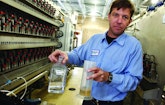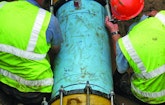
Interested in Education/Training?
Get Education/Training articles, news and videos right in your inbox! Sign up now.
Education/Training + Get AlertsMesa Water stands for the Mesa Water District in Costa Mesa, Calif. It could also stand for reliability, as the district has adopted a number of practices that essentially guarantee a continuous supply of high-quality water for its customers.
The district has implemented a proactive infrastructure maintenance program, preaches efficient water use, attacks leaks, and has constructed a brand new water treatment plant, the Mesa Water Reliability Facility (MWRF).
According to Jerry Vilander, district water operations manager, Mesa Water is completely self-sufficient in terms of its water supply, which is drawn from the groundwater aquifer. “We’re able to supply 100-percent local water,” he says. “We do not need to rely on outside water except as a secondary source.”
Mesa Water
Mesa Water was formed in 1960 to provide water to the growing population of Costa Mesa, portions of adjacent communities and the John Wayne Airport near Newport Beach. Today, it serves approximately 110,000 residents, plus millions of visitors.
Its raw water comes from the Orange County groundwater basin, pumped from eight wells, each capable of producing between 1,800 and 2,400 gallons per minute. Water from two of the eight wells is slightly amber-tinted — believed to be caused by ancient redwood forests buried far beneath the surface, Vilander explains. While the color has no impact on the quality or safety of the water, it is removed in the MWRF, which includes a nanofiltration system.
Rated at 6,000 gallons per minute, the improved MWRF (see sidebar) processes about 50 percent more water than the previous ozonation plant, while using less energy per gallon. It also assists groundwater cleanup by preventing the tinted water from migrating into the clear water zone above it.
Finished water travels to the community through a 350-mile-long distribution system, consisting of pipes ranging in diameter from 6 to 42 inches. The system includes 3,800 hydrants and 5,400 valves. Two reservoirs provide 9 and 18.7 million gallons of storage capacity, respectively.
Proactive maintenance
While one goal of Mesa Water is having a completely self-sufficient water supply, a companion standard is providing unblemished service to its customers. Water utilities can only achieve such a record if their infrastructure functions flawlessly — a condition requiring diligent maintenance, including proactive preventive measures.
It’s a perfect description of the Mesa Water program, which the staff refers to as “perpetual infrastructure renewal.”
Kurt Lind, district business administrator, explains: “When we talk about infrastructure here, we’re talking about a complete plan to maintain all our infrastructure and replace our assets as necessary. This ensures that our water system is in great shape. It’s not just maintaining and replacing infrastructure, but it’s also maintaining accurate records of work that helps us improve our operations through performance measures.”
Mesa Water’s computerized maintenance management system (CMMS) is called “MaintStar,” and was selected following a competitive bidding process among a number of outside contractors. It’s about seven years old now.
“We performed a needs assessment,” says Lind. “We evaluated our operation as a business — how we were operating, where we could improve — and found a system that met our specific needs.”
The CMMS tracks all labor, equipment and material requirements, and forms an annual work plan, complete with specific goals to be accomplished each month. It also sets performance indicators — how long it takes to turn a valve, for example.
Progress is monitored through biweekly meetings to schedule tasks with all supervisors, and monthly meetings to monitor progress toward established goals. Mesa Water compares its cost of performing work such as valve replacement or valve maintenance to contractor pricing to ensure the district remains cost-competitive and delivers quality work to its customers. “It’s a great Mesa Water business practice that allows us to measure our performance internally to our planned costs and externally to contractors’ cost,” Lind says. “It’s how we deliver value to our customers.”
The data gathered and generated by the process is critical as well. “This is a challenge to water systems,” observes Vilander. “Sometimes they have no real data to back up their actions, no formal tracking system. Our system delivers QA/QC data we then use to prove the excellence of our operation to our board and to our customers.”
The system is paying off, and Mesa Water sees direct benefits in the areas of valve and meter replacements.
“Before, we were replacing 20 to 25 valves a year,” Vilander says. “Now we’re doing 50 valves with less people, and we’ve improved the way we replace valves in the system. We were doing one here, one there. Now we’ve started targeting valves, grouping them, and replacing more in one area. We’re planning the work.”
Likewise with meters. “We replace our meters regularly,” says Lind. “We’ve been on a 15-year replacement cycle, although we may change that. We don’t just react to a stuck meter; that’s not how we work.
“Typically, we replace about 1,300 meters per year. While some agencies have a meter testing program based on the age of the meter, we’ve run a statistical analysis that includes meter use, type of service and age.”
Lind says the surveys produced a predictive model that indicated replacing meters approximately every 15 years was about right. “Otherwise, we’d be spending more money (on labor and the sheer cost of the meters) than we’d be getting back in return,” he notes.
The numbers are also helping the district better target meters that are candidates for replacement. “We are recording different pressure zones in the system, and targeting meters based on age, pressure and flow-through,” Lind says. “This way we can be more proactive in certain areas, and establish better time frames.”
Little water loss
Vilander and Lind point out that Mesa Water generally loses very little water through leaks, yet its crews are no less vigilant exercising and maintaining valves and hydrants on a regular basis.
“If we find a problem, we attack it immediately and fix it right away,” Vilander explains. If it turns out to be a long-term issue like a bad section of main, the district staff quickly notifies its water board and seeks the necessary funds to repair it. “We move swiftly to replace a main,” says Vilander. “A Band-Aid approach will not work.”
The clay soil in the area helps, as leaks do not migrate underground and are quickly visible on the surface.
Water use efficiency is another critical activity at Mesa Water.
Justin Finch is the district’s conservation specialist, and Barry Carlson is customer services manager. Together, they concentrate on water use throughout their service area, tracking water consumption, working with customers, and improving water efficiencies. “Our goal is to try to help everybody use water wisely,” Finch says.
The district employs a uniform rate structure to convey the strongest price signal at the very first billing unit. It’s also part of the Orange County Regional Alliance, which has a goal of reducing water usage across the region by 20 percent by 2020 — in compliance with the California Water Conservation Act of 2009.
The district measures its performance according to new American Water Works Association audit standards, which take into account the financial, operational and water resource practices of an agency.
In addition to the meter testing program, Mesa Water has adopted audit recommendations regarding well balancing, evaluating the true costs of imported water, and third-party verification of meter billing accuracy. “According to the audit, we have rated ‘Excellent’ the last two years and are very close to ‘World Class,’ the top ranking,” says Carlson. “We are moving in the right direction.”
Helping customers
Mesa Water keeps in close contact with its water users through a variety of programs. The flagship program is what Finch calls the “Water Wise House Calls” program.
“When our customers receive a water bill they think is high, they can call us to get advice on reducing usage,” he says. At the same time, Finch targets the top 20 percent of residential customers and uses special mailings regarding water use efficiency.
“Most of our customers are on top of their indoor water use,” explains Finch. “Outdoors is where they can get most of their savings.
“We want them to take control of their irrigation controller,” he adds. “Say ‘hello’ to it, find out where it is, how it turns on and off. We show them how to use the controller, how to adjust the sprinkler schedule based on the weather.”
Finch says the Mesa Water team also advises users on types of sprinkler heads to use to save water. They recommend rotating sprinkler nozzles to reduce evaporation and ensure more water gets to the plants, and low-flow drip irrigation for shrubbery.
“We also hold water conservation forums,” he explains. The meetings are attended by public entities, cities and other municipal developments that have a lot of resources tied up in landscaping. Mesa Water also sponsors landscape workshops and maintains a wise water use garden at its home office.
“We try to put a face on the district for our customers,” Finch explains. “We want them to say, ‘Hey, these guys want my water bill to be lower and they’re going to show me how.’ ”









